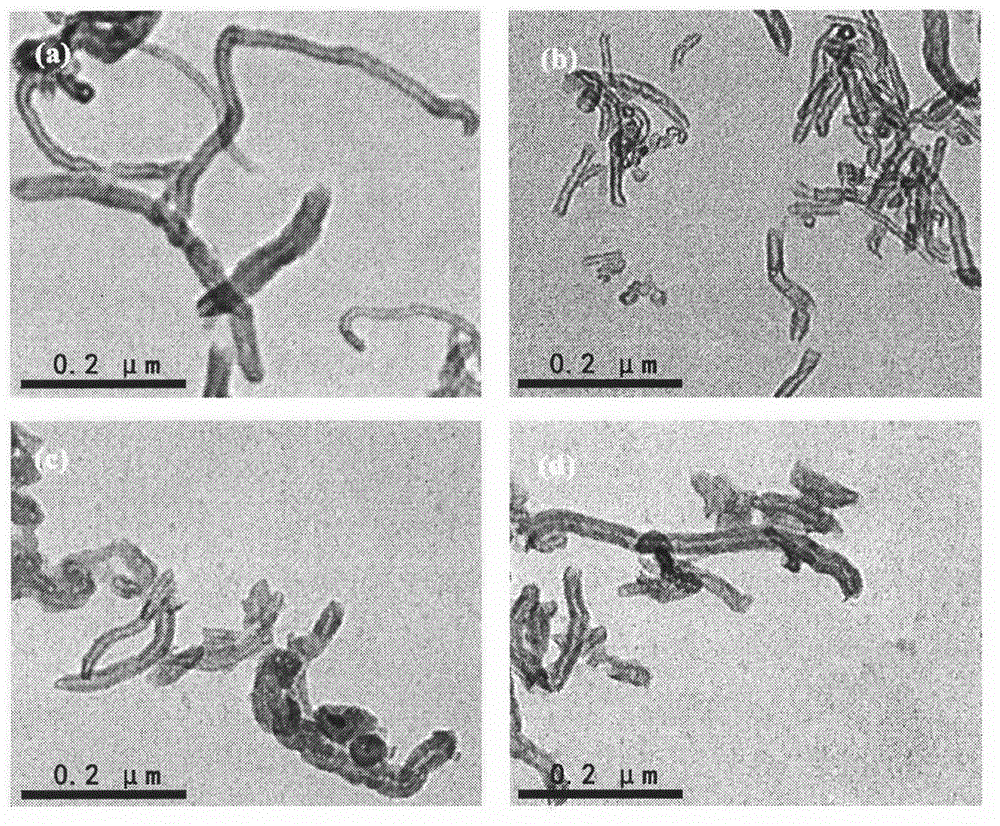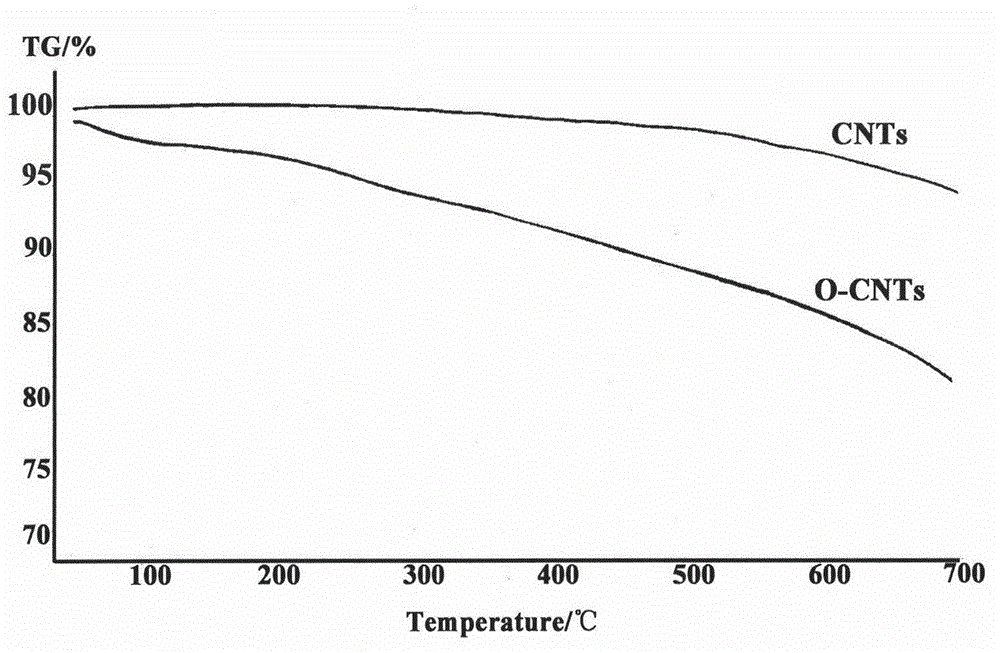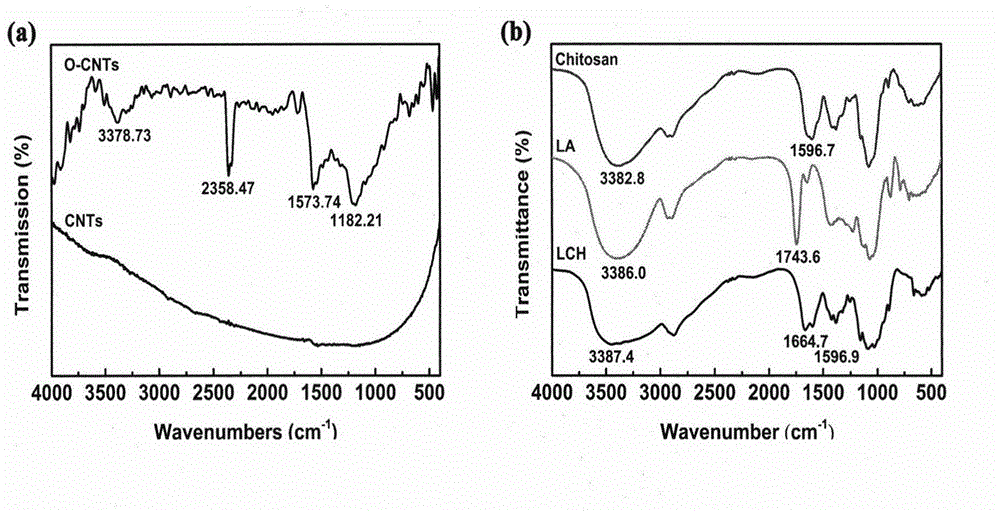Hepatoma targeting carbon nano tube loaded with doxorubicin hydrochloride and preparation method thereof
A technology of doxorubicin hydrochloride and carbon nanotubes, which is applied in the field of medicine, can solve the problems of doxorubicin hydrochloride side effects and limited application, and achieve the effects of small side effects, good effect and simple process route
- Summary
- Abstract
- Description
- Claims
- Application Information
AI Technical Summary
Problems solved by technology
Method used
Image
Examples
Embodiment 1
[0023] Example 1: Preparation of liver cancer-targeting carbon nanotubes loaded with doxorubicin hydrochloride
[0024] (1) Carboxylation of carbon nanotubes: 200 mg of MWNTs (length 1-2 μm, diameter 10 nm) was added to the H 2 SO 4 / HNO 3 (v:v=3:1) in 100mL of the mixture, sonicate for 5min. Then, the mixture was heated to reflux at 80 °C with magnetic stirring for 4 h. After the oxidation reaction, the mixture was added to 150 mL of ice water and left to stand overnight. The carbon tubes in the mixture were precipitated, and the upper layer of the clear brown transparent liquid was sucked out with a dropper, and the lower layer was filtered with a sand core funnel, and continuously washed with deionized water until neutral. A small amount of deionized water was ultrasonically dissolved and freeze-dried to obtain O-CNTs. TEM showed that the length of carbon nanotubes became shorter and the surface was smoother after acidification. Infrared characterization product with ...
Embodiment 2
[0028] Example 2: In vitro release of liver cancer-targeted carbon nanotubes (O-CNTs-LCH-DOX) loaded with doxorubicin hydrochloride
[0029] Precisely weigh 2 mg of liver cancer-targeting carbon nanotube (O-CNTs-LCH-DOX) freeze-dried powder loaded with doxorubicin hydrochloride of the present invention and disperse them in phosphate buffers of pH 7.4, pH 6.5 and pH 5.5 respectively, Make the concentration 1mg / mL, take 1mL of the sample solution in a dialysis bag with a molecular weight cut-off of 3500, put it into 100mL of the corresponding phosphate buffer, and dialyze it in a constant temperature oscillator at 37°C (frequency 100r / min). Take 1mL at regular intervals and add 1mL of corresponding phosphate buffer at the same time, parallel 3 times. The sample that is taken out is filtered and HPLC is measured doxorubicin hydrochloride content, and the cumulative release curve of 24h is as attached Figure 4 , the in vitro release of liver cancer-targeting carbon nanotubes (O-...
Embodiment 3
[0030] Example 3: In vitro safety evaluation: hemolysis test
[0031] Take 10 mL of fresh rabbit blood and place it in a 200 mL beaker containing glass beads, gently stir with glass beads to remove fibrinogen, and obtain defibrillated blood. Add about 10 times the amount of 0.9% sodium chloride injection, shake well, centrifuge at 1500rpm for 15 minutes, remove the supernatant, and then wash the precipitated red blood cells with sodium chloride injection for 2 to 3 times according to the above method until the supernatant is no longer obvious. until red. Aspirate 3 mL of red blood cells, dilute to 150 mL with 0.9% sodium chloride injection to prepare a 2% red blood cell suspension, and store in a 4°C refrigerator for later use. Take 40 10mL centrifuge tubes and divide them into three groups, which are liver cancer targeting carbon nanotubes (O-CNTs-LCH-DOX) group loaded with doxorubicin hydrochloride, negative control tube (0.9% normal saline nc), positive control tube (dist...
PUM
 Login to View More
Login to View More Abstract
Description
Claims
Application Information
 Login to View More
Login to View More - R&D
- Intellectual Property
- Life Sciences
- Materials
- Tech Scout
- Unparalleled Data Quality
- Higher Quality Content
- 60% Fewer Hallucinations
Browse by: Latest US Patents, China's latest patents, Technical Efficacy Thesaurus, Application Domain, Technology Topic, Popular Technical Reports.
© 2025 PatSnap. All rights reserved.Legal|Privacy policy|Modern Slavery Act Transparency Statement|Sitemap|About US| Contact US: help@patsnap.com



